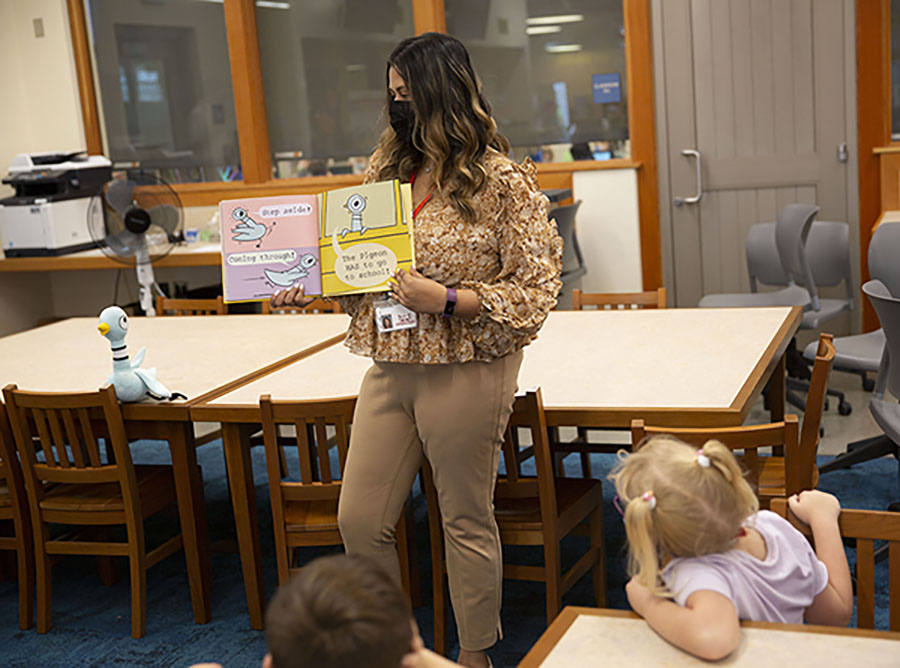 Nov. 16, 2021 — Teaching credential candidate Julieta Silva turned the page on “The Pigeon Has to Go to School” by Mo Willem, then turned the book around so the children seated at the library table could see the pictures of the reluctant pigeon.
Nov. 16, 2021 — Teaching credential candidate Julieta Silva turned the page on “The Pigeon Has to Go to School” by Mo Willem, then turned the book around so the children seated at the library table could see the pictures of the reluctant pigeon.
“What if there is math, or numbers?” Silva read from the book designed to help children with common school anxiety. “Why does the alphabet have so many letters?”
Silva, who plans to earn her teaching credential in spring of 2022, is student teaching at Washington Elementary School in Santa Barbara under a new teacher residency program for teaching credential candidates at CSU Channel Islands (CSUCI). Like the other 40 students in the program, she has her tuition paid for and is receiving a $10,000 a year stipend.
“It’s awesome to be part of this program and I live in Santa Barbara, so I don’t have to commute to Ventura County,” Silva said. “Getting this residency was very important and a blessing because I didn’t know what I was going to do for living expenses.”
Professor of Education and Dean Brian Sevier, Ph.D. has been working toward getting the residency program established ever since he arrived at CSUCI in 2014 because he knows what it’s like to make ends meet as a student teacher.
“Most teachers will tell you they worked an additional job during their student teaching. I worked two additional jobs just to survive,” Sevier said. “If we’re going to truly live up to our mission to create pathways that get impediments out of students’ way, we have to change this practice.”
CSUCI’s School of Education has established residencies for student teachers at the Oxnard School District (OSD), Oxnard Union High School District (OUHSD); the Rio School District and the Santa Barbara Unified School District (SBUSD).
Sevier sees this residency program as a win for both the student teachers and the districts. Aside from tuition and the stipend, the residents sign an agreement to work in the district for two to four years if they are offered a job after completing the residency program.
Schools benefit as they often get student teachers who grew up in the area — something Sevier calls a “grow your own” model for teachers and districts. The residency program also allows for more diversity in the teaching pool, Sevier said.
“Residencies allow us to reach a much more diverse pool of candidates because there are candidates who will not go through the student teaching experience because it is so cost-prohibitive,” Sevier said. “The districts want to create pathways for their alumni to return to teach in the schools they came from. And recruiting locally helps the teaching corps better reflect the demographics of the diverse student body.”
Silva is teaching at the same elementary school she attended and credential candidate Christopher Guevara is student teaching at Rio Rosales Elementary School in his native Oxnard. He is currently working as a resource specialist for children with learning challenges and plans to go into special education after he graduates. He believes being from the area has a distinct advantage.
“It comes down to the majority of the population in Oxnard being Chicanx and being able to communicate not just their language, but to understand where they came from and how it is in their homes,” Guevara said. “Knowing the culture really helps me connect with the families and keep them in the loop.”
The 20 residents in the OUHSD are being funded by the district. The 19 in the Oxnard or Rio School district are being funded by a grant written in partnership with CSUCI and the Ventura County Office of Education.
The two residents in Santa Barbara are funded through the SBUSD and the James S. Bower Foundation, which seeks to enrich the social and cultural environment in Santa Barbara, with support for education high on the list.
Foundation President Jon Clark said the Foundation’s missions are closely aligned with CSUCI’s dedication to making sure first generation, low-income students have a pathway to college.
SBUSD has seen tremendous success with a SBUSD initiative called Program for Effective Access to College or PEAC — a college readiness and access program for low-income, first generation high school students — and sees the teacher residency program as the next step.
“If you’re a PEAC student from Santa Barbara and you want to go to CSUCI and come back to teach in your district, we want to show you there’s a pathway to get there,” Clark said.
The California Commission on Teacher Credentialing is about to release a new request for proposals for residency grants and two faculty members in the CSUCI School of Education, Assistant Professor of Education Talya Drescher and Associate Professor of Education Michelle Dean, are writing a grant to expand the residency program to support students seeking a dual credential in Special Education and Elementary Education.
“Special educators are always in high demand in this county and we will be creating this new residency to support these dual credential students as they seek to support the families, schools and communities we serve,” Sevier said.
